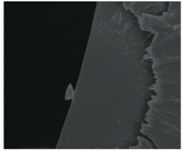Brittleback in Polyimide Coated Capillary Tubing
The Application Notebook
Polyimide coated fused silica capillary tubing is widely used in the separation sciences. In some instances a condition called brittleback can appear in the tubing. Its causes and remedies are discussed.
Polyimide coated fused silica capillary tubing is widely used in the separation sciences. In some instances a condition called brittleback can appear in the tubing. Its causes and remedies are discussed.
Fused silica capillary tubing is produced in lengths ranging from a few hundred meters up to several kilometers. Gas chromatography (GC) column manufacturers wind the tubing onto a cage, typically in lengths from 10 to 120 m. Other users may trim off only a few meters to make a transfer line, retention gap, or waveguide. Regardless of the use, the tubing must be cut or cleaved to length. In almost every instance, it is then connected to a fitting, valve, liner, or similar device. On occasion, the user may find that the end of the tubing has become prone to breakage. This unwanted brittleness near the end, when caused by internal damage, is referred to as brittleback. This application note presents information on the causes of brittleback, techniques for minimizing its frequency, and guidance for removing it once it is found.
Brittleback Causes
Capillary tubing develops brittleback because the internal surface has been mechanically damaged by debris. When the tubing is subsequently stressed by being bent or handled, it breaks. The most common debris sources are shards of glass from a poor cleave or an earlier break, metal particulates from fittings or valves, particulates/precipitates from unfiltered solutions, or particulates from dirty work or glassware surfaces. This debris is driven down the tubing by gases or liquids introduced into the tubing. The higher the head pressure and the larger the internal diameter, the further the debris can be driven down the tubing. Figure 1 is a good example of a brittleback event. End face analysis can be performed for verification and can sometimes clearly identify the debris source (1).

Figure 1: Brittleback example - this glass debris induced break occurred ~35 cm from the end of the tubing. The glass debris is less than 4 µm in size and is typical of debris from a poor cleave.
Minimizing Brittleback
Brittleback is minimized by using techniques that reduce the generation and introduction of debris. Proper cleaving technique is vital and has been discussed previously (2). Cleaning of all valves, connectors, and supply lines should be done as part of routine maintenance. Glassware used for tubing related processes should be cleaned and solutions adequately filtered (0.2 µm recommended). Any surfaces that may contact the end face of the capillary should be kept free of debris (3). When introducing gases or liquids, ramp the head pressure up slowly, if possible, to minimize the initial linear velocity.
When Brittleback Occurs
Once brittleback develops the first sign is an unwanted break,which only exacerbates the problem due to the additional glass debris generated. The best course of action is to remove and discard the damaged section. This is done by moving down the tubing and performing a good cleave. A starting point is 50 cm, but Polymicro suggests moving 1 m if possible. This is repeated as needed.
Conclusion
Brittleback is an unwanted condition when using capillary tubing. Proper techniques and good laboratory practices can minimize its occurrence.
References
(1) J. Macomber, LCGC Application Notebook, 54 (Feb 2007).
(2) "Cleaving Procedure", The Book on the Technologies of Polymicro,
Polymicro Technologies Publication, p.A-2, (2011).
(3) J. Macomber and L. Begay, LCGC Application Notebook, 72 (Sept 2003).
Polymicro Technologies, a subsidiary of Molex, Inc.
18010 North 25th Avenue, Phoenix, AZ 85023
tel. (602) 375-4100, fax (602) 375-4110
Website: www.polymicro.com

The Benefits of Custom Bonded Silica
April 1st 2025Not all chromatography resins are created equal. Off-the-shelf chromatography resins might not always meet the rigorous purification requirements of biopharmaceutical manufacturing. Custom bonded silica from Grace can address a wide range of separation challenges, leading to real performance improvements. Discover more about the latest innovations in chromatography silica from Grace, including VYDAC® and DAVISIL®.
5 Things to Consider When Selecting a Chromatography Silica
April 1st 2025Particularly in the pharmaceutical industry, drug purity isn’t just a goal – it’s essential for achieving safety, stability and efficacy. However, purification is easier said than done, especially with challenging molecules like DNA and RNA “oligonucleotides,” due in large part to their diversity and the range of impurities that can be generated during production. Enter DAVISIL® chromatographic silica, with a wide range of pore diameters and particle sizes to meet your specific application, performance and sustainability requirements. Before you choose the chromatography resin for your next purification application, take a look at these 5 considerations.
Automating Protein Purification: Efficiency, Yield, and Reproducibility
March 27th 2025Recent advancements in automated protein purification stress the importance of efficiency, scalability, and yield consistency. This eBook compares different purification platforms, highlighting their impact on downstream applications and demonstrating how automation enhances throughput and process control.
MilliporeSigma: Ultrapure Water for Sensitive LC-MS Analysis of Pesticides
March 25th 2025The aim of the study was to illustrate the efficiency of Milli-Q® water purification systems in eliminating pesticides from tap water, thereby producing and delivering reliable and consistent-quality ultrapure water suitable for pesticides analysis















